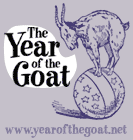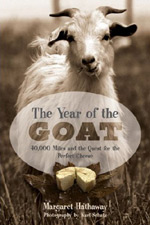As we were talking, Ken led us through the processing facility. We began at the end, so as not to contaminate the work space, stepping into a shallow tray of bleach before entering a large refrigerated room. The floor was slick with ice, disinfectant, and scattered drops of blood, and boxes of wrapped trays of meat were stacked on pallets around its perimeter. At the far end, two gloved workers rolled caul fat and intestines into packets that, in some Native American cultures in the Southwest, are spiced, baked and considered a delicacy. Three freezers holding nine hundred lamb and goats each radiated from this room, and Ken led us past rows of hanging carcasses, each one stamped with the purple ink of the USDA inspector.
Through a heavy door, the air changed from frigid to steamy, and we were assaulted with the stench of organs and their leaking fluids. We entered a corridor, off which several rooms branched, each devoted to the processing of a certain part of the carcass. In one room, a man packed intestines, which are sent for casing to sausage-makers around the country. In another, glistening piles of liver are packed for export to Saudi Arabia. Pelts, which are pulled off whole by machine with an audible pop, are sent to Turkey for processing; lungs go to a dog-treat manufacturer; blackened-green bile from the gall bladder is collected for a pharmaceutical company. What amazed us, as we followed the corridor to the kill floor, was how little waste there was. Each part of the animal had a use, and the plant was organized so that the parts could be sorted as efficiently as possible. On the kill floor, we watched as a dozen workers performed their specific tasks in quick succession. On average, it takes twenty minutes for an animal to pass through the chute, onto the kill floor, and into the freezer.
Up a flight of stairs, a door led outside to a breezeway, and then an elevated set of pens, in which lambs were being led by a Judas goat into the chute. Two workers stood at the end, jolting the animals with enough electricity to render them brain dead. In an instant, prongs at the sheep's brains and in the fleece near their hearts delivered a zap that collapsed them, after which they were handed through a small door to the kill floor.
The Judas goats milled outside the chute, then returned to the pens, where they collected another batch of sheep. These goats, one worker said, chewed tobacco and did their job just like anyone else. One goat, they claimed, was in his thirties, and had been working there for more than two decades. Ken said that his wife sometimes comes out to feed and give a little attention to the Judas goats, who live in a separate pen, and wear collars to distinguish themselves from the animals for slaughter.
In addition to taking care of Ranchers' caprine employees, Ken's wife Jackie works with the Humane Society and is a committed vegetarian. We were astounded, and curious how this dynamic works at home. Ken seemed to have tremendous respect for his wife's beliefs, and said that his profession actually causes no strain on their relationship. At home, he shares her vegetarian diet (unless he's craving meat, in which case he cooks it himself), and he's read the books that have had such a profound impact on her lifestyle.
We'd already seen Ranchers' facility, and witnessed firsthand how careful the workers are to give each animal a humane death. But the fact that Ken is married to such a staunch animal lover made his efforts to provide the animals with relatively comfortable pens and a quick kill seem somehow more genuine. These were still living creatures, moving in a bleating stream toward death, but this death came quickly, and with as little pain as technology could deliver.
It was a far cry from "The Jungle," which I'd recently reread, and whose horrors have haunted me since. It was tidy and efficient, the workers were not in peril, the animals didn't seem to suffer. But in some way, the antiseptic nature of the plant was as bothersome as gore would have been. It is the tide of technology, the march of progress that has turned the taking of life into one stop on an assembly line that starts on the hoof and ends wrapped in a plastic tray.
I eat meat, and I accept that there is a measure of violence in that act. What was strange and a little disorienting at Ranchers' was how little of that violence was in evidence. —MMH


